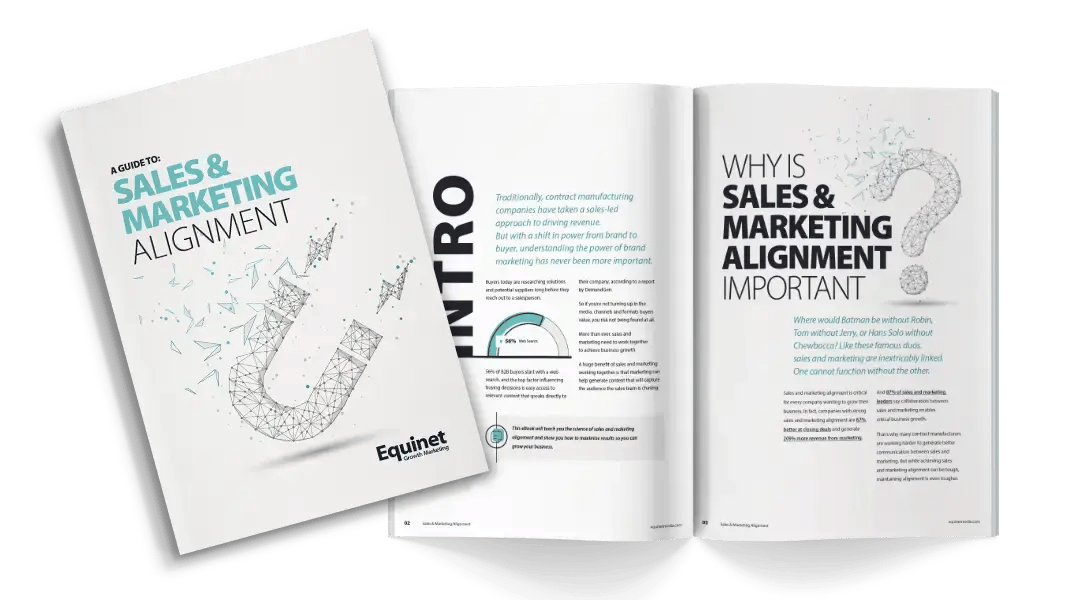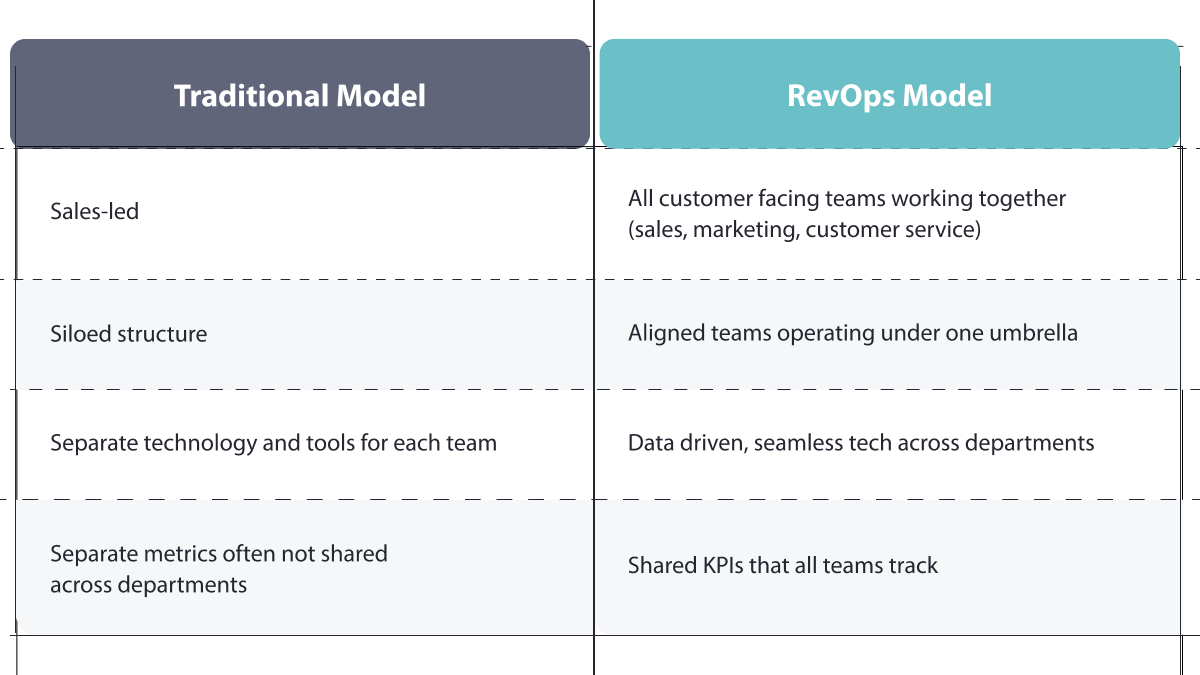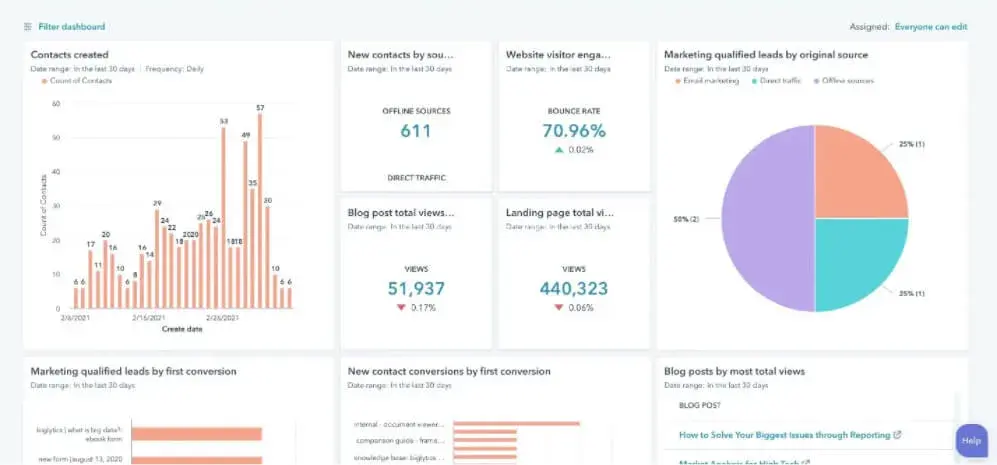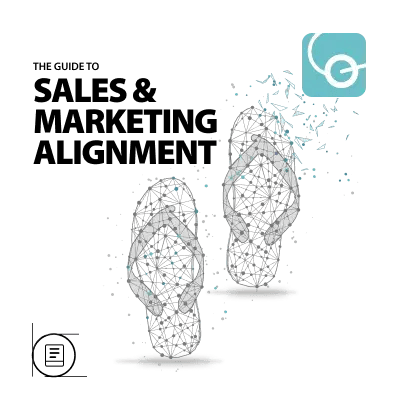Guide to Sales & marketing alignment
Traditionally, contract manufacturing companies have taken a sales-led approach to driving revenue. But with a shift in power from brand to buyer, understanding the power of brand marketing has never been more important.


No time to read now?
Introduction
Traditionally, contract manufacturing companies have taken a sales-led approach to drive revenue. But buyers today are researching solutions and suppliers long before they are ready to talk with Sales. And successful contract manufacturers are adopting a market orientation.
More than half of B2B buyers start with a web search today, and the top factor influencing their buying decisions is easy access to content that speaks directly to their company, according to a report by DemandGen.
You might only get found if you turn up where and when they are searching. And how you turn up is paramount in influencing how ideal customers perceive you. So more than ever, Sales and Marketing need to work together to optimise your pipeline's volume, value and velocity.
Why is sales and marketing alignment critical?
Where would Batman be without Robin, Tom without Jerry, or Hans Solo without Chewbacca? Like these famous duos, sales and marketing should be inextricably linked. One cannot function without the other.
Companies with sales and marketing teams closely aligned are 67% better at closing deals and generate 209% more revenue from marketing, so Sales and Marketing alignment are critical for every company wanting to grow.
A HubSpot report states, "87% of sales and marketing leaders say collaboration between sales and marketing enables critical business growth". But while achieving sales and marketing alignment can be tricky, maintaining alignment is even more challenging.
Bridging the gap between sales and marketing
An enduring partnership between sales and marketing requires the two teams to operate as a single, revenue-generating organisation.
The key to alignment is implementing tools and practices that help teams work better together. Once shared goals and a common language are adopted, there's less room for doubting each other's performance. The results are plain for all to see.
When aligned, Marketing knows which leads to nurture and which are ready to pass to sales. And Sales have more confidence in the opportunities they receive.
The rise of Revenue Operations
Some companies are taking sales and marketing alignment a step further. Revenue Operations (also known as RevOps) ensures alignment and accountability across the three departments responsible for driving revenue - sales, marketing, and customer service.
It's a relatively new concept. But companies are catching on fast. Gartner predicts that 75% of the highest-growth companies in the world will deploy a RevOps model by 2025.
Sales and marketing alignment concentrates on the communication needed to attract and convert customers. RevOps, on the other hand, prioritises the entire customer lifecycle to increase revenue potential.
Moving from traditional sales operations to a RevOps model:

A successful RevOps model is focused around three pillars:

Process: RevOps creates uniform processes to foster accountability and trust. As your teams combine to convert prospects into customers, you will see shorter sales cycles, improved retention, and a higher volume of upsells.
People: You need people to bring together and manage your process and platforms - this may be a specific RevOps team, or accountabilities may be distributed amongst existing team members.
Platform: Access to accurate information is key to success. By connecting and aligning your technology, you create a clear and precise story around your revenue pipeline, so your teams have clear directions for how they can impact the pipeline.
How to align sales and marketing
A six step framework:
- Establish a closed-loop reporting system
- Collaborate on buyer persona development
- Define your sales funnel
- Implement a service level agreement (SLA)
- Track and communicate progress towards goals
- Meet regularly
1. Establish closed-loop reporting
Data is essential for maintaining sales and marketing alignment and has helped fuel the RevOps revolution. Data on progress toward goals to analyse lead quality and measure marketing ROI.
So the first step in improving alignment between Sales and Marketing is establishing a closed-loop reporting system that tracks crucial sales and marketing metrics.
Creating a single view of the customer
Establishing a single view of the customer will enable your sales and marketing teams to effectively manage every lead throughout their entire lifecycle and across all channels.
It allows for an accurate dialogue between the two teams, enabling intelligent decision-making and timely sales engagement.
Crucially, it also closes the 'sales and marketing loop'. The marketing team gets feedback about which leads turn into customers and can measure marketing channels in terms of revenue and other metrics.
Integrating the systems that track sales and marketing metrics achieves a single view of the customer.
Integrating systems
The two pieces of a closed-loop reporting system are:
- Marketing software that helps you with lead generation and management
- A CRM (Customer Relationship Management) system that allows you to track and measure sales activities
By integrating these systems, you will have data on every lead from creation to the opportunity to close.
You'll see every interaction a prospect or customer has with your company. And if you integrate your ERP, you will achieve a trustworthy single source of truth.
Many marketing software platforms automatically integrate with popular CRM systems. For example, HubSpot's marketing platform integrates with Salesforce.com, SugarCRM, Microsoft Dynamics, NetSuite, Sage, and others.
Increasingly, organisations prefer to adopt one system that contains CRM software, marketing automation, landing page creation, a blogging platform, a content management system and other features that help with their sales and marketing operations.
The HubSpot CRM, for example, offers the convenience of all these things in one place. It acts as a single point of truth in your business, so you can be confident that your sales and marketing teams align around the same data, analytics, and outcomes.
Data is crucial for maintaining sales and marketing alignment and has helped fuel the RevOps revolution.
2. Collaborate on buyer personas
Buyer personas help to create a common language across your sales and marketing teams. They help marketing teams create messaging and content to resonate with your ideal customers. And they help sales teams to know who they're selling to and what they care about.
Both sales and marketing should be involved in developing your buyer personas.
Your marketing team will have data on where your current online visitors are located, how they found your website, their roles, and details about their demographics.
Meanwhile, your sales team will understand the types of customers your business attracts, what they want to achieve by investing in a service like yours, and what their objections to purchasing might be.
Give your buyer personas a memorable name. These names can help your team to focus by asking questions such as "What would Quality Clive do?" or "What would Engineer Edward think of this offer?" Buyer personas help to create a common language across your sales and marketing teams.
3. Define your sales funnel
Very often, sales and marketing teams will view the funnel quite differently. They might differ over the number of stages a lead has to pass through before becoming a customer. And they may use different terms to describe each stage.
For your sales and marketing teams to be aligned like your buyer personas, you need a unified picture of the funnel and a common language that allows everyone to focus on the shared objective.
What does the ideal sales lifecycle look like?
Various stages of qualification should define the way you talk to and engage with people as they move from unqualified lead status to (happy) customers:
Unqualified LeadAn unqualified lead is added to your database by filling out a form or subscribing to a blog or newsletter but has yet to reveal more about their identity and specific pain points.
Marketing Qualified Lead (MQL)
An MQL is an individual with whom you have decided it is worth investing marketing time and effort to develop as a potential prospect. They will have qualified themselves by providing more information about their identity and business - and are engaging more deeply with your brand. At this stage, though, the company thinks they still need to be ready to buy; therefore, they require further nurturing to qualify for entry into the sales cycle.
Sales Qualified Lead (SQL)
The lead has met all the criteria to be 'handed over' to sales. They may have responded to a sales-led CTA or signalled themselves 'ready' in other essential ways. They are entering a new phase of targeted marketing activity designed to help the business define the specific opportunity they represent and close the deal.
Sales Opportunity
You have the required data about the lead to consider them a 'good fit'. A genuine and achievable sales opportunity is defined and timetabled in the pipeline.
(Happy) Customer
The opportunity has been closed and turned into a sale by your sales team - backed up with plenty of customer intelligence collected from all the previous stages. The more seamless and aligned your sales process is, the happier and more confident your customer will be in your power to deliver. And the more you continue to impress them and speak to their experiences with relevant content, the more likely they will buy more from you - and recommend you to others.
Sales and marketing alignment is key to effective lead scoring
To make sure the customer experience is as seamless as possible, both sales and marketing teams must agree to the qualification criteria for the various shifts between lead, MQL and SQL.
Typically, this is done by digital lead scoring: A point value you assign to each lead based on the information they provided and their level of engagement with your brand.
Lead scoring helps you organise and prioritise different sales and marketing efforts for other groups of people in your database.
The kind of data gathered by your CRM system and used for lead scoring can include:
Demographic information
Details such as a lead's age, gender, job role, estimated salary etc. This helps to build a picture of the lead and their role within the business.
Firmographics
The size and type of company the lead works for, what they do, and their needs and current supplier status. These are critical elements that define a good organisational fit.
Online behaviour
What is the lead looking at on your website? What kind of content have they downloaded? And where do their interests lie - what questions are they seeking answers to?
Email engagement and subscription status Track specific clickthrough activity in newsletters, responses to webinar invitations, blog subscribers and podcast downloads.
Social engagementSocial activity can be a crucial indicator of areas of interest, engagement levels, and receptivity to brand content and messaging.
Once you've agreed to all the criteria you want to collect, you must assign a point value to each. You must then configure them within your CRM to score each lead accordingly.
Choosing the right digital tools to automate lead scoring
How easily you can set up scoring within your CRM differs according to the software you use.
The right CRM software will help you rapidly and precisely score and segment lead data. It automatically updates a prospect's status and triggers new workflows as customers become 'qualified' for new sales and marketing phases.
Your software should also support different scoring systems for products and segments for more sophisticated operations.
Technology like HubSpot's Predictive Lead Scoring app can also leverage more sophisticated machine learning techniques to help you better predict which customers are ripe for conversion and when. Based on past sales information and customer tracking, it can suggest new scoring criteria that may help identify great leads more quickly - making your operations more efficient and effective.
Defining lead scoring is a continuous process
Although the right digital tools will make your life easier, you will still need to manually review and update the scoring criteria you use.
You'll need to regularly check that the leads passed through to sales are of the right quality. Are too many or too few leads making it through? Are they leads suitably primed to have the conversations you were planning? Do your qualification criteria need to be tweaked?
As new market conditions arise, you will inevitably need to shift your selection and hand-off criteria. Most importantly, your sales and marketing teams are always on the same page.
To align your sales and marketing teams, you must adopt a unified picture of the funnel and a common language that allows everyone to focus on the shared objective.
4. Implement a service level agreement (SLA)
Traditionally, an SLA defines what a customer will receive from a service provider. But SLAs also serve internal operations, with sales and marketing agreements often the most crucial.
The problem is that historically, sales and marketing have functioned with different key performance indicators (KPIs) and, therefore, different goals. Most of these goals are separate — sales may focus on monthly revenue while marketing hone in on website traffic.
When sales and marketing are aligned, they prioritise shared goals, too. The SLA formalises the shared goals for revenue growth.
It's a two-way process:
- Marketing commits to delivering a certain quantity and quality of leads each month to help the sales team meet its quota.
- Sales then commit to following up on those leads promptly and making a specified number of contact attempts before abandoning the lead.
Setting up an SLA for the marketing team
The best way to set KPI targets is to review current conversion rates across the whole funnel and work backwards.
First, ask yourselves the following questions:
- How many quality leads do the sales team require to reach revenue goals?
- What percentage of these leads originate from marketing? If the sales team is doing some prospecting, the marketing team isn't responsible for 100% of the leads needed to meet the quota.
- What percentage of these leads is influenced by marketing? Even if leads originate elsewhere, the marketing team may be involved in nurturing those leads until they are marketing qualified.
Answering these questions will enable you to identify the percentage of the pipeline the marketing needs to drive and determine your SLA. You could base the SLA in pounds to make it more convincing for your sales team.

85% of marketers with an SLA think their marketing strategy is effective - HubSpot
How to calculate SLA in pounds
To calculate an SLA in pounds, you will need to determine the percentage of the sales quota the marketing team is responsible for each month and the value of each MQL.
This will allow you to identify how many leads marketing must deliver to reach the total. To calculate the value of an MQL:
- Compile a list of all the campaigns or offers that have generated leads in your pipeline, such as white paper registrations, demo sign-ups, and trade shows. You can also segment your leads by type of customer, such as large vs mid-sized or small businesses.
- Match your recent customers against the campaign or offer that led to their first visit or conversion, then work out the average revenue per customer for each lead source. (If you're segmenting by type of customer, you can also calculate the average income per large vs. medium or small customer.)
- Find the average close rate for each campaign or offer. Then multiply the average revenue per customer for the campaigns and offers against the close rate to determine the average MQL value.
For instance, if the average revenue per customer from a lead converted on a whitepaper is £150,000, and the average close rate on those leads is 5%, then the value for each whitepaper MQL is £7,500.
Based on those figures, an SLA might look like this:

Setting up an SLA for the sales team
To set up the SLA for the sales team, start by figuring out how quickly a sales rep should follow up on a new MQL. How many follow-up attempts per lead should the sales team be able to complete each month? How many contact attempts should the sales team make for every MQL of a particular type?
Be sure to base every decision on actual data. Let's take the ideal number of contact attempts as an example. Your chances of a successful connection may improve each time you call a lead. But those calls also have a cost, as they require the sales rep's time. Eventually, the potential return for making additional calls will diminish.
To identify the optimal number of times a salesperson should call a lead based on the probability of that activity:
- Start with stale leads - Select a portion of leads that have been in the sales pipeline for at least a few months.
- Group data - Examine your CRM records to identify how often sales attempted to contact each lead before closing. Create cohorts of leads contacted once, twice, three times, or four times.
- Make estimates - Divide the average hourly cost of a sales rep's time by the number of calls they can make in one hour to determine how much a contact attempt costs your business.
- Benchmark - To benchmark the profitability of these contact efforts, divide the average revenue for each customer by the cost of calling a lead one, two or three times, etc.
- Plot data - Plot your data in a chart with the number of contact attempts as the X-axis and the profitability score as the Y-axis. Additional contact attempts tend to create more sales, so you should see a line that gradually increases profitability with the number of attempts.
- Note results - Note where the lines level off, which means the profit-per-customer isn't increasing despite the additional contact attempts. This levelling-off point is the recommended number of contact attempts to use in your SLA.
5. Track and communicate progress toward goals
Once you've implemented the SLA, you can use the data from your closed-loop reporting to measure progress towards your goals.
This stage is vital as it allows you to spot any areas of concern before they become big problems, by which point they might be too late to do anything about.
Sales and marketing dashboards
Sales and marketing dashboards provide a snapshot of your team's progress based on data from your closed-loop reporting system.
Build your dashboards into your CRM to be shared across the sales and marketing teams.
This clear snapshot tracks your progress toward goals and can help your team meet their goals by encouraging healthy competition. If people fall behind, they'll be more motivated to fix problems independently.
The marketing dashboard
The marketing dashboard is an effective way to visualise your marketing team's progress towards its SLA goals.
If leads are low, the marketing team must do more work to deliver on its SLA promises. For example, developing new content, increasing social media engagement, or spending money on PPC or other channels. If leads surpass the goal, they can start planning for the next month or quarter. They could even hold back a few pieces of content for next month's promotions.
The HubSpot marketing dashboard allows you to track your most critical metrics in one place that is visible to everyone on your team.

The sales dashboard
Sales dashboards give visibility of all follow-ups and contact efforts. By digging into the CRM data, you can create graphs showing how the sales team is progressing on its SLA goals.
Two key dashboards are:
- New leads that were not called within X hours, as specified in the SLA
- All leads that weren't called at least X times within X days
Daily reports will appear when specific teams or individual sales reps need to catch up on their goals. That early warning allows sales managers to step in and provide coaching to help the team or individual get back on track.
HubSpot's reporting and sales analytics software allows you to quickly build dashboards to keep track of the insights that matter most. Or you can choose from one of their dashboard templates, so you spend less time building reports in spreadsheets and more time working toward your goals.
Monthly reports
Dashboards provide a daily update of the most critical metrics for your sales and marketing teams. But you can also create a monthly sales and marketing report for a more in-depth overview of your strategies and results.
Share the monthly report with the entire company to create transparency about your activities and highlight how your efforts impact the business.
The marketing team's report should illustrate the impact of its recent activities, including:
- Visits, leads and customers by source
- Performance of marketing assets (web pages, landing pages, CTAs)
- Speed from conversion event to sales follow up
The sales team's monthly report should demonstrate what is happening with the leads generated by marketing, including:
- Actual sales results vs sales targets
- Total sales cycle - how long it takes sales to convert leads into customers
Using a CRM like HubSpot makes generating detailed sales and marketing reports easy, saving you time and ensuring accurate reporting.
6. Meet regularly
Weekly meetings
Get sales and marketing teams together at least once weekly to discuss recent results and upcoming activities. The size of your organisation will determine the format of this weekly meeting. If you have only a handful of sales and marketing staff, the meeting can be a highly interactive session, welcoming discussion from everyone in the group. But if you're a larger company with dozens of staff, the meeting should be a quick, high-level overview to keep momentum.
Tips for running weekly meetings:
- Keep it short and to the point - 30-40 minutes is ideal; make sure it is at most an hour.
- Pick timing carefully - hold it at the end of the day to avoid disrupting the sales team's prime calling time.
- Pick presenters - designate one person from sales and one from marketing to deliver their half of the update covering the status of goals and highlighting any big wins or upcoming plans.
Monthly management meetings
The monthly management meeting is an opportunity to dive deeply into results and discuss strategy, upcoming plans, and any potential issues that could create misalignment between sales and marketing.Keep each other informed
Even with an SLA in place, dashboards and regular meetings, marketers may still need other ways to demonstrate to the sales team how their efforts are helping to achieve revenue goals.
Your sales team are busy and don't want distractions, so consolidate the information you need to convey into a simple, newsletter-style report and avoid sending long reports. For example, send a weekly marketing update covering planned promotions, a new guide being launched, and the topic of this week's blog post. You could also send product updates informing your sales team about changes to your services to ensure they are fully informed when speaking to prospects.
Your sales team can then go ahead and promote these on their social media and refer to them when speaking with customers.
Set up a content creation process
You want to target your prospects with appropriate content at each stage of the buyer's journey. Your sales team are talking with prospects all the time. They know what excites them about your company and the common objections to purchasing. You will need a simple process for capturing this insight.
You also need a regular meeting to discuss what content your sales teams would like to have to share with prospects or attract more leads. You could allocate five minutes of your weekly marketing meeting to this. Or you could hold a separate, more extended meeting on a monthly or quarterly basis to discuss ideas.
To keep ideas from meetings, set up a place where sales can add or references them for content creation. Make it somewhere they can access quickly and easily.
Conclusion
Now you have a framework for aligning your sales and marketing teams so you can boost revenue and grow your business.
One of the best things about this framework is that it can be reviewed and scaled up as required. You can tweak elements such as your buyer personas, your definition of an MQL, or your SLA to reflect changes in market conditions or customer needs.
And as you get more comfortable using data to manage your sales and marketing teams, you'll find new ways to optimise your campaigns, improve your sales follow-up and generate more revenue.
You can also adjust the format of your weekly or monthly meetings to fit with changes to the size or structure of your organisation. You can invite new managers or other key personnel to your meetings. By bringing in your customer service team, for example, you could make the move towards a RevOps model.

Want to save a copy? Well send a copy direct to your inbox.
























